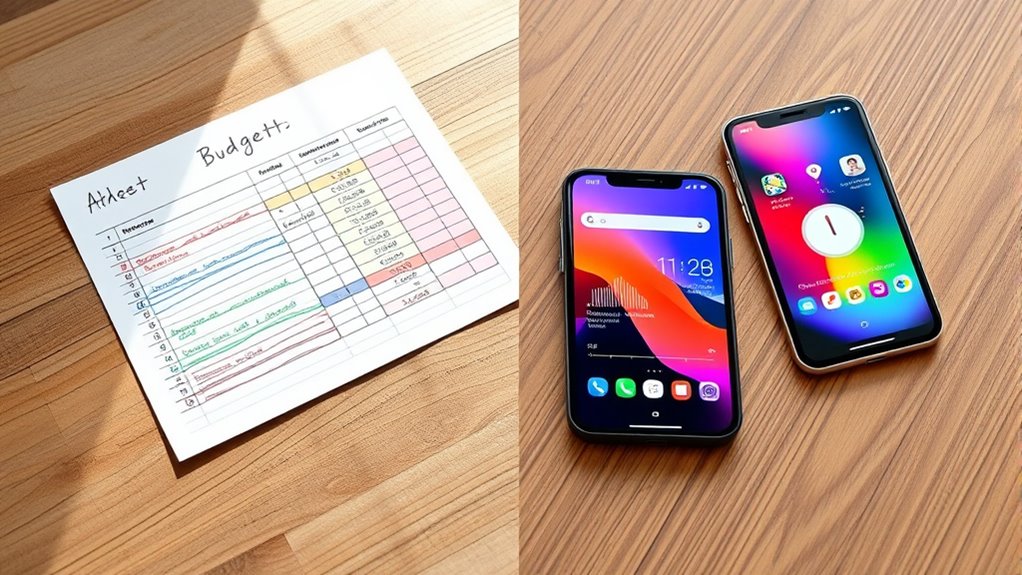Choosing between budget templates and apps depends on your needs for simplicity and automation. Templates are easy to use, low-cost, and work well for quick, straightforward setups, but they lack automation and can become restrictive. Budgeting apps offer automatic tracking, real-time updates, and more customization but often come with subscription fees and security concerns. If you’re looking for a balanced understanding, explore how each option can fit your financial style.
Key Takeaways
- Budget templates are simple, cost-effective, and easy to use but lack automation and advanced features.
- Budgeting apps offer real-time tracking, automation, and personalized insights but often require subscriptions.
- Templates are ideal for beginners or quick setups, whereas apps suit users needing detailed, dynamic financial management.
- Templates may pose security risks due to limited data protection; apps generally include security features but raise privacy concerns.
- Both options have limitations: templates lack automation and customization, while apps depend on internet access and may be complex.
Advantages and Disadvantages of Budget Templates

Have you ever wondered if using budget templates is the right choice for managing your finances? Budget templates are simple and easy to use, making them great for quick setups and straightforward tracking. They don’t require technical skills, so you can start budgeting immediately. However, they lack automation, so you need to manually update your expenses and income, which can be time-consuming and prone to errors. Templates also offer limited customization, which might not fit your specific financial situation. If your budget becomes complex, templates can feel restrictive and harder to adapt. On the upside, they’re cost-effective and easy to access, making them ideal for beginners or those who prefer paper or spreadsheet formats. Still, they may fall short for more detailed or dynamic financial management needs. Cookies and tracking features can also influence how effectively you can manage your finances with certain tools. Additionally, the absence of security features in basic templates could expose users to data vulnerabilities if not properly managed. Moreover, the lack of automation capabilities means users miss out on features that can streamline and enhance financial oversight.
Benefits and Drawbacks of Budgeting Apps
Budgeting apps offer several advantages that can streamline your financial management. They automatically track your spending, categorize expenses, and provide real-time updates, helping you stay on top of your budget effortlessly. With mobile access, you can manage your finances anytime, anywhere, making it easier to think about your goals. Many apps also offer visual tools like charts and graphs, giving you quick insight into your financial health. Additionally, some apps incorporate features inspired by financial education to help users improve their money management skills. They often utilize data analysis to identify spending patterns and suggest improvements. Furthermore, as technology advances, these apps are increasingly integrating modern tools to enhance user experience and accuracy. However, there are drawbacks to contemplate. Apps often require a stable internet connection and can involve subscription fees. Privacy is another concern, as sensitive financial data is stored digitally and may be vulnerable to breaches. Moreover, as AI in Education advances, some budgeting apps are beginning to utilize intelligent systems to provide more personalized financial advice, though this is still an emerging feature. Additionally, some users find apps less personalized than traditional methods, which can limit their effectiveness for complex financial situations.
Frequently Asked Questions
How Do Budget Templates Compare to Apps in Terms of Customization?
When comparing how budget templates and apps handle customization, you find that templates offer limited flexibility, often requiring manual adjustments to fit your needs. In contrast, apps provide more dynamic customization options, letting you easily modify categories, add new fields, and adapt the tool as your financial situation changes. You can tailor apps to suit your specific goals better, giving you more control over how you track and manage your budget efficiently.
Can Budget Apps Integrate With Other Financial Tools Effectively?
Think of a budget app like a skilled translator, seamlessly communicating with your other financial tools. Many apps offer integrations with bank accounts, credit cards, and investment platforms, making it easier to get a full financial picture. You can automate transactions, track expenses, and sync data across tools. While some integrations work smoothly, others may require manual updates, so choose an app that aligns well with your existing financial ecosystem.
Are There Specific Budget Templates Suited for Small Businesses?
If you’re looking for budget templates suited for small businesses, you’ll find many tailored options. These templates often include categories like expenses, revenue, and cash flow, making tracking easier. You can customize them to fit your specific needs, whether you run a retail store or a service-based business. Using these templates helps you stay organized, monitor your finances regularly, and make informed decisions to grow your small business effectively.
What Security Measures Do Budgeting Apps Typically Implement?
Think of budgeting apps as digital safes for your finances. They typically implement security measures like encryption, two-factor authentication, and regular security audits to safeguard your data. You’re encouraged to use strong passwords and keep your app updated. These steps are like locking your door and installing security cameras—helping ensure your financial information stays private and safe from potential threats.
How Do Cost Differences Impact Long-Term Budgeting Choices?
You should consider how cost differences influence your long-term budgeting choices. If an app has a higher upfront or subscription cost, it might offer more features, but over time, it could strain your budget. On the other hand, free templates save money initially but may lack advanced tools. Balancing cost with functionality helps you select the best option for sustainable, effective budgeting.
Conclusion
Choosing between templates and apps is like selecting a compass or a map—you need what guides you best. Templates are your steady compass, simple and familiar, but they might lack the detail you crave. Apps are your dynamic map, offering real-time guidance and flexibility. Whichever you pick, remember it’s about steering your financial journey with confidence. Let your choice be the lighthouse that keeps your budget on course, shining bright through every financial tide.









